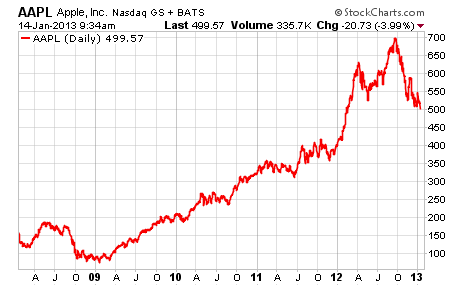What jumps out at you when you look at this chart?

Surely the first thing you notice is that Apple (NASDAQ: AAPL) has been on quite a five-year run. But the next thing you might notice is how pronounced the world’s largest stock’s recent pullback has been.
Not since late 2008 – at the height of the recession – has an Apple slump been this sustained. Shares have fallen nearly 30% since topping $700 in late September. Yesterday the stock dipped below $500 for the first time since last February.
Apple’s current funk is now approaching four months. The chart tells us that since the start of 2009, no other Apple pullback has lasted more than about six weeks.
To be fair, the stock’s recent slump comes on the heels of its greatest run. Take one more look at that chart and notice what the stock did in the first three quarters of 2012. It basically doubled from where it was in late 2011. That kind of move isn’t sustainable – not even for the world’s largest company.
A pullback was inevitable, it seems. What has made this slump last longer than any other recent Apple slump, however, has everything to do with the company’s image.
Apple’s two recent product launches – the iPhone 5 and the iPad Mini – failed to wow people the way previous versions had. The company’s very public mea culpa about its failed “Maps App” on the iPhone 5 was a rare embarrassing moment for a company that had theretofore seemed incapable of screw-ups.
My colleague Jason Cimpl believes this was a fluke. In fact, he wrote as much in this space on Monday. And he may be right.
But the fact of the matter is it’s been a while since Apple has truly introduced something new. It just keeps churning out iPhones, iPads and iPods – all of which are starting to lose their luster, at least on Wall Street.
IPhone 5 sales have been slower than expected of late. According to research firm OTR Global, Apple will ship only 35-37 million iPhone 5 units this quarter – well shy of the 47 million units analysts were expecting.
While iPad Mini sales have been booming since their October release, the unveiling of Apple’s latest e-tablet failed to gain traction with investors the way past product releases had.
In the past – as Jason expertly detailed on Monday – new iPhone or iPad announcements routinely have resulted in a 10%-12% short-term boost for Apple’s stock. Conversely, after the dual iPhone 5 and iPad Mini unveilings this past fall, Apple shares plummeted dramatically both times.
That may seem like picking nits – and it is. Somewhere, Tim Cook is throwing up his arms and screaming, “Are you not entertained?!” But this is the most profitable company in the history of the world we’re talking about. It should be held to a higher standard.
Rest assured: business is still good at Apple. Great, in fact. The company is coming off its best year ever, after all – racking up a record $41 billion in profits from October 2011 through September of this year. As Jason wrote, there’s a decent chance those numbers will improve when the company releases fourth-quarter earnings next Wednesday.
Among the general public, Apple is still revered.
But on Wall Street, Apple seems to be developing an image problem. For now, it’s causing the largest stock on the market to be stuck in the mud.
*Full disclosure: I currently own shares of Apple.
Editor's note: When I first considered a high-yield investing strategy, my goal was to devise a portfolio that yielded between 6% and 8% annually. To be sure, that's a worthy starting point. But years from now, I should expect to own a portfolio that yields 25%, 50% and even 100% on the cost basis of many of the investments in that portfolio.
If you would like to learn how you can boost the yield of your portfolio… and earn bigger monthly payouts… then consider taking a free, 30-day trial to our income service, High Yield Wealth. You'll discover exactly how we are built our cash-cranking portfolio and get access to every special report and investment recommendation. Click here to try High Yield Wealth, free.
 Facebook
Facebook
 Twitter
Twitter